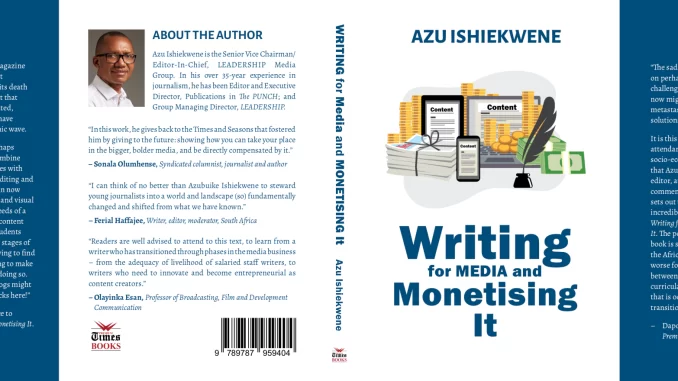
In today’s world, where Artificial Intelligence (AI) is gradually encroaching on human creativity, limiting the impact of creative writing as a powerful tool of communication, Azu Ishiekwene’s book, Writing for Media and Monetising It addresses the dual nature of technology — as both a challenge to traditional media writing and an advantageous tool for the media.
One does not need to directly follow in Azu Ishiekwene’s footsteps. However, his decades of expertise and experience, along with those of other veterans in the media industry shared in the book, offer a valuable set of instructions and principles. These insights would tremendously help not only upcoming writers but also anyone willing to polish their writing skills and earn income from it. The book delivers valuable guidance on media writing, journalism, and advanced methods for earning money by transforming skills into a lucrative career.
In the first chapter, Azu Ishiekwene discusses the essence of media writing, detailing what it involves and examining its various types, including print journalism, online content creation, broadcast writing, and social media content. The chapter underscores the need for flexibility, as each type of media writing requires its specific approach. For example, the author illustrates how writing for a newspaper differs from writing for a blog or other forms of writing. He also underscores the importance of understanding one’s target audience, which is a factor that serves as a bedrock for successful media writing.
The book offers various techniques for monetising writing, including self-publishing, freelance writing, and brand content creation. Azu Ishiekwene affirms the need for writers to build their brands in today’s competitive world, noting that writers must establish a strong online presence by taking advantage of social media to give their work visibility and build connections with their respective audience.
Chapter Two outlines strategies to help writers choose subjects that will engage their audience, provide knowledge and value, compel them, and generate income, especially by leveraging social media platforms. He shares several options for writers who depend on writing as their main source of income and emphasises the importance of making informed decisions when choosing subjects that will attract valuable engagement and conversions.
The author explores substance and style as essential components of effective writing. He references The Elements of Style, a book by William Strunk and EB White, as a key guide that helped him develop a clear and refined writing style. He also reflects on the challenges he faced while trying to discover his unique style and voice and offers key elements of style, with examples, to assist his audience. Turning his attention to digital media, he emphasises the significance of Search Engine Optimisation (SEO) as a crucial tool for reaching a specific audience online. Azu Ishiekwene provides tips on how writers can use internal linking to boost search engine rankings.
The book offers various techniques for monetising writing, including self-publishing, freelance writing, and brand content creation. Azu Ishiekwene affirms the need for writers to build their brands in today’s competitive world, noting that writers must establish a strong online presence by taking advantage of social media to give their work visibility and build connections with their respective audience. He cites Dr Reuben Abati as one of the prolific writers who built his audience base at The Guardian by sharing stories of his weekly experiences as a Molue commuter. Azu uses Reuben Abati’s experience to encourage writers to start building their audience from a network of family, friends, neighbours, and associates.
More profoundly, the book addresses the challenges faced by writers and the opportunities available for those passionate about growth and innovation. With many conversations about the media industry being in a state of constant change — marked by the rise of digital media and the decline of analogue print media — the author views this irregular change positively, as opportunities often disguise themselves as challenges.
I can confidently attest that “Writing for Media and Monetising It” is Azu Ishiekwene’s gift to everyone who hopes to find their voice. To those seeking solutions to the chaos in the media industry, this book will definitely serve as an ultimate guide.
The author highlights job security as a major challenge in the media industry due to the rise of online jobs, leading to fewer full-time writing positions. However, he also notes that freelance writing has opened several opportunities for writers. He urges writers to continue honing their skills and strive for relevance in their field.
Writing for Media and Monetising It provides a detailed guide for writers to learn and grow in their niche while creating works that leave a lasting impact on their audience and the world at large. In each chapter, the author shares valuable lessons and takeaways to help both aspiring and established writers use their pens and the media as powerful tools for making their voices heard. The book serves as an eye-opener for aspiring writers looking to monetise their writing, connect deeply with their audience, and leave a lasting mark.
I can confidently attest that Writing for Media and Monetising It is Azu Ishiekwene’s gift to everyone who hopes to find their voice. To those seeking solutions to the chaos in the media industry, this book will definitely serve as an ultimate guide.
Toyin Falola, a professor of History, University Distinguished Teaching Professor, and Jacob and Frances Sanger Mossiker Chair in the Humanities at The University of Texas at Austin, is the Bobapitan of Ibadanland.
END

Be the first to comment